Pork ribs (either St. Saint Louis-style spare ribs or baby back ribs are simple to cook, but it can be hard to tell when they’re done unless you’re a seasoned pit master.
After reading this blog to the end, you’ll know definitively when your pork ribs are done.
You can tell when pork ribs are ready in a number of ways, but different sources may give you different information, leaving you wondering which is the best way to tell.
Which method can you trust? Which one really works? Do you just believe what your coworker says after cooking three racks of ribs and calling themselves a pitmaster?
Do you break a few racks trying to figure it out? It’s embarrassing to say that I may “know someone” who did that and it cost them a lot. There’s no need for any of that, I promise.
As a barbecue enthusiast, I’m always seeking the ideal balance of tenderness and texture when cooking pork ribs. Nailing the right internal temperature is essential to achieving ribs with juicy meat that pulls cleanly off the bone. But with different styles of ribs and cooking methods, target temperatures can vary.
In this comprehensive guide, I’ll demystify the ideal internal temp for different types of pork ribs so you can impress guests with expertly prepared BBQ every time Whether smoking low and slow or grilling hot and fast, you’ll learn how to remove ribs from the heat at just the right moment for mouthwatering results
Why Internal Temperature Matters
Let’s start with a quick overview of why monitoring temperature is so critical when cooking ribs
- Ensures any bacteria are killed and pork reaches safe eating temperature
- Indicates when collagen in meat has broken down for desired tenderness
- Controls moisture levels so meat stays juicy and doesn’t dry out
- Allows meat to reach peak tenderness without becoming overcooked
- Takes the guesswork out of determining doneness visually
For these reasons, the pros swear by thermometers over instincts to guarantee perfect ribs every time. Now let’s break down target temps.
Baby Back Ribs – 175°F
Tender, succulent baby back ribs come from the loin and contain less connective tissue. Here’s what to know about their ideal internal temp:
- Shoot for 175°F for juicy, tender meat
- At this temp, collagen melts while still retaining moisture
- Color test: Meat will appear slightly pink, juices run clear
- Tenderness test: Meat pulls cleanly from bone with light tug
- Avoid going over 180°F or ribs can become dry or tough
For baby backs, 175°F hits the rib sweet spot. Now let’s look at meatier spareribs.
Spareribs – 185°F
With more fat and collagen from lower on the belly, spareribs require a higher internal temperature:
- Target around 185°F for ideal texture
- Helps render fat and melt collagen for tender meat
- Color test: Meat looks opaque all the way through
- Tenderness test: Meat pulls from bone very easily
- Don’t exceed 195°F or meat dries out and toughens
That 10-degree higher temp gives spareribs time to reach their peak tenderness.
St. Louis Style Ribs – 195°F
A hybrid between spare and baby back ribs, St. Louis style ribs also need a higher target:
- Shoot for 195°F for perfect doneness
- This temp allows collagen to fully dissolve for moist, fall-off-the-bone meat
- Color test: Inner meat looks opaque with no pink
- Tenderness test: Bone should be visible with meat cleanly pulled back
- Don’t let temp go above 203°F or meat will be overcooked
Thanks to their high collagen content, St. Louis ribs shine at 195°F-195°F.
Key Doneness Indicators Beyond Temperature
While temperature offers valuable guidance, also rely on these visual and textural cues:
- Meat surface looks dark brown with a nice crust
- Meat has visibly shrunk back from the ends of the bones
- Ribs bend without breaking when lifted in the middle
- Juices run clear when pricked with a fork
- Meat feels tender when pierced but not mushy
Learn to master the thermometer, but also sharpen your senses so you can “read” your ribs.
Accounting for Carryover Cooking
One other temperature tip: Remember that carryover cooking will raise the internal temp 5-10 degrees after removing ribs from the heat.
To allow for carryover:
-
Remove ribs 5-10 degrees before target temp
-
Carryover cooking will finish them perfectly
-
Allow 10-15 minutes to rest before eating
This prevents overshooting your ideal temp.
Matching Temp to Cooking Method
Target temps for ribs apply across all cooking methods. But here are a few method-specific tips:
Smoking: Cook low and slow until the internal temp hits optimal degree. Wrap at stall point to power through.
Grilling: Cook hotter and faster. Monitor temp more closely to avoid overshooting.
Baking: Use lower oven temp like 250°F to give collagen time to melt.
Braising: Simmer below boiling point, check temp periodically until complete.
Putting Your Knowledge to Use
You now have the complete intel for monitoring internal temperature when cooking different styles of pork ribs via various methods. Here are a few final tips for putting your new skills into practice:
-
Invest in a good digital instant read thermometer
-
Always insert probe into the thickest part of meat
-
Factor in carryover cooking when removing ribs from heat
-
Confirm doneness using visual and textural clues as well
-
Keep notes during cooks to refine ideal temps for your setup
With the right tools and knowledge, you can become a true pork rib pro. Now get outside and start honing your barbecue mastery! Perfectly cooked ribs await.
The Takeaway: Temperature Trumps Time
Unlike with chicken or steaks, recommended cook times can really vary for pork ribs depending on style, method, and other factors. The internal temperature is a far better indicator of ideal doneness. While 195°F may be the ribbon-winning competition temp, for your home grill, find the ideal temperature that brings each rib type perfectly in balance. Once you master your thermometer and see those ribs glistening, you can confidently serve outstanding barbecue every time.

Common Methods for Checking Ribs
Some of the more popular ways of determining if your pork ribs are done include:
- Visual inspection
- Bend test
- Probing
- Bone twisting
- Actually cutting into the ribs (10/10 don’t recommend this one)
- Simply going by time
Some of these work better than others, but non of them are 100% accurate. Don’t worry, though—I’ll explain in more detail how to find out if your pork ribs are done.
The most popular method is looking for the bones to start peeking out. More than a quarter of an inch of bones will start to stick out along the slab, which is called “pull back.” That’s usually a pretty good indication that the ribs are about ready.
We’re not saying it’s 100% accurate, but it’s a simple visual clue that only needs a quick glance.
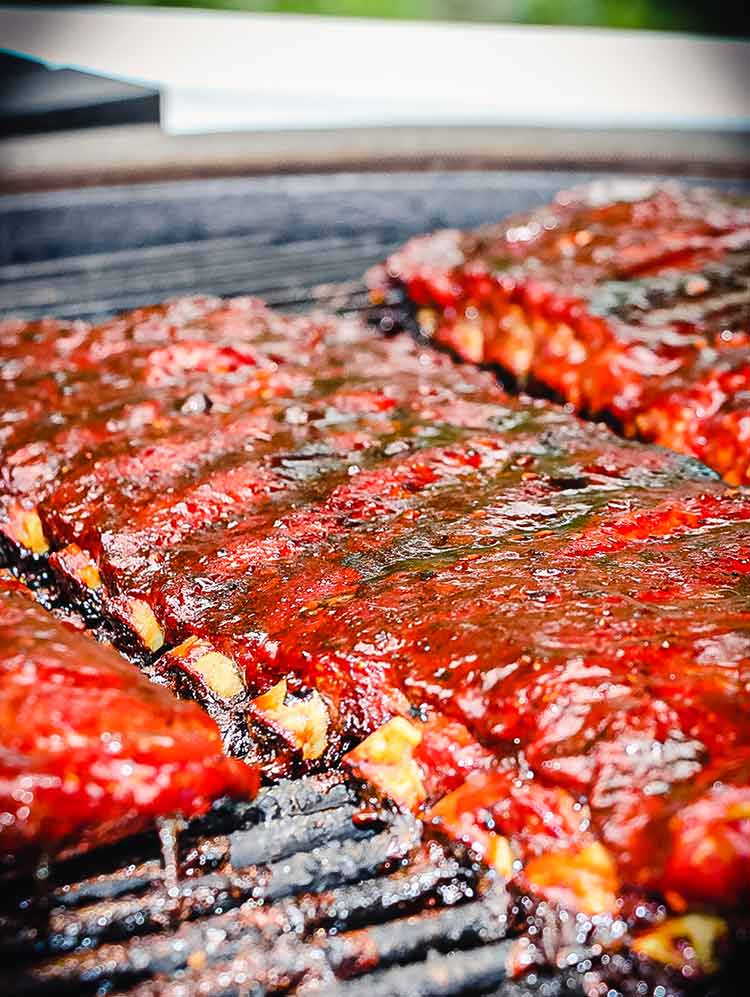
Another method is to bend the slab of ribs. The bend test is done with tongs or gloves and takes a little longer than just quickly looking at the bones, but it’s not hard. Simply pick up the slab and give it a slight bend towards a U shape.
If there is no separation or cracking between the ribs, they’re not ready. A slab of ribs that’s ready cracks easily between the bones and almost breaks in two.
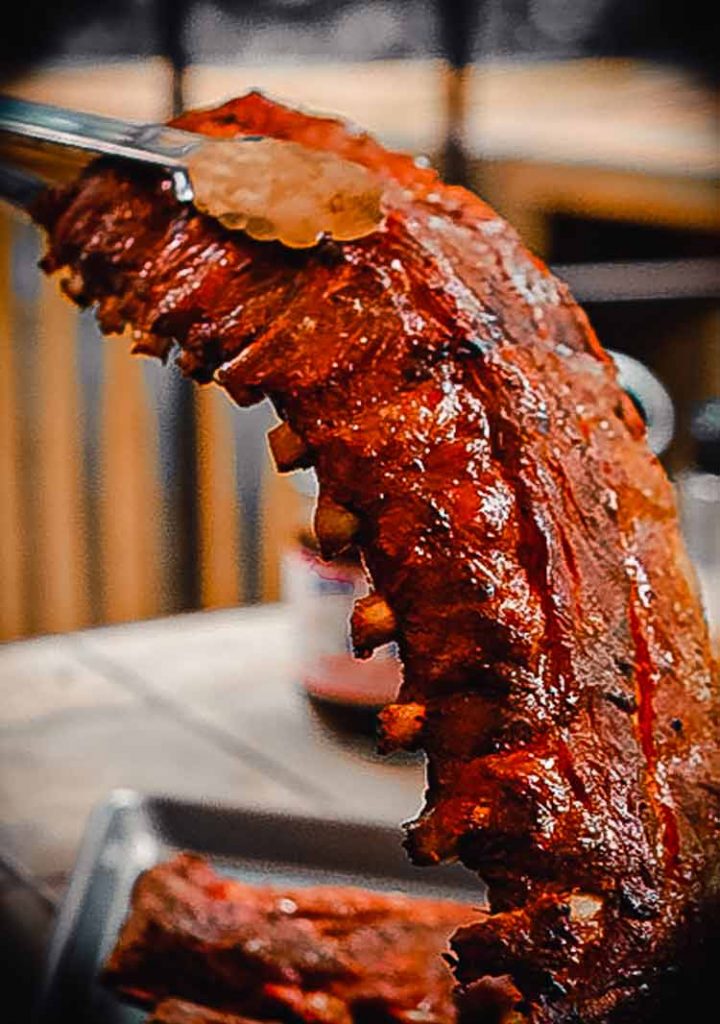
Many pit masters will use what’s called the toothpick test. If you have experience cooking a brisket, you’ll be familiar with this method.
I use the point of a temp probe needle and simply probe the meat in between the bones. You want there to be little resistance and for the probe to easily slide into the meat and come out cleanly.
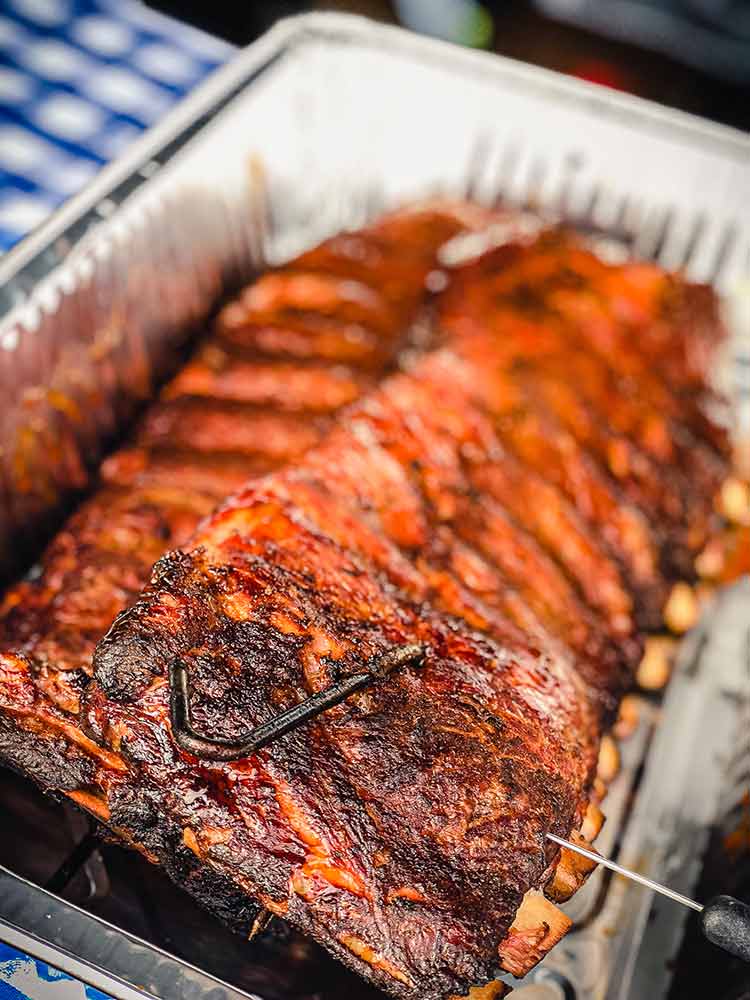
There are also ways like cutting into the ribs, twisting a bone, and not checking at all. So, some grillers only cook their ribs for a certain amount of time and then take them off the heat. I call this the “ready or not, here I come” method.
At What Temperature Are Pork Ribs Done?
The USDA recommends cooking pork ribs to an internal temperature of 145° F for safety reasons. However, at this temperature the meat is rubbery and tough. Pork internal temp and pork done temp are clearly not the same thing.
Pork ribs aren’t ready to be served until their internal temperature reaches 195° F to 203° F. At this temperature, fat and collagen throughout the meat has broken down and flavored the ribs.
This contributes to the overall taste and texture of the ribs. If the bones peek out and they probe easily at 195° F, I pull them off the grill. There are no bones that stick out if the probe is still tight. I let them heat up to 203° F and then take them off.
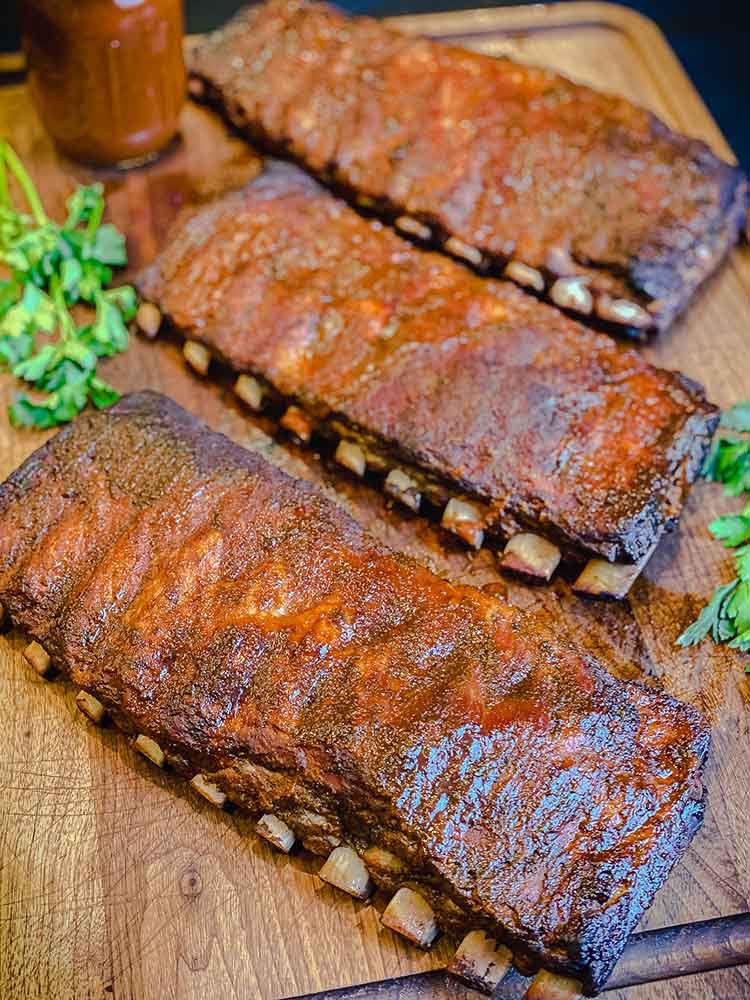
Finally, the meat should keep its shape after biting into it. You may have heard that ribs are perfectly cooked when they “fall off the bone. ” That is actually not true. If the meat falls off the bone, it’s overcooked and has a mushy texture—not ideal for any occasion. The moral of the story is that you should trust a thermometer (like the ThermoWorks Signals or the ThermoWorks Smoke X2 RF) to give you juicy ribs that everyone will want more of!
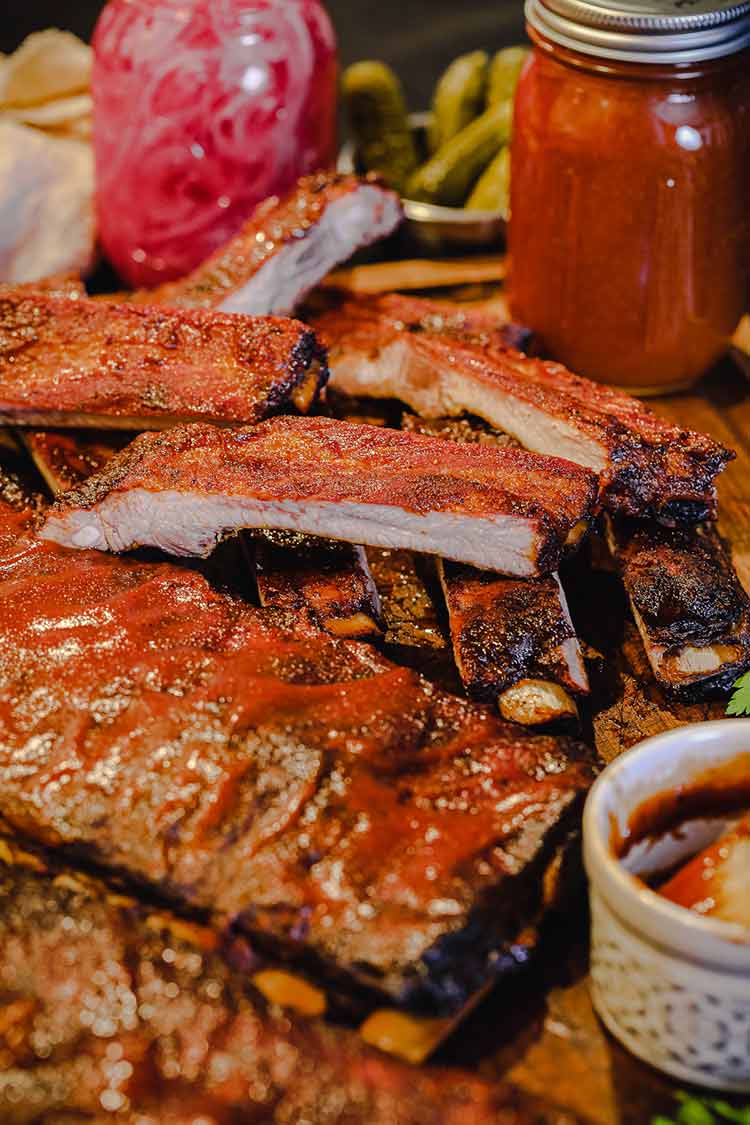
What Temperature Should I Cook My Ribs?
FAQ
Are pork ribs done at 180?
Are pork ribs done at 165 degrees?
What temperature should pork ribs be cooked at?
What is the reason for the pain in the ribs?
Pain in ribs can be due to various reasons including trauma (rib fracture), pulled muscle, joint inflammation, referred pain (liver, spleen, and lungs) and due to underlying undiagnosed auto-immune disorder.
Can you eat pork ribs at 145 degrees?
With a meat thermometer, of course. Just stick the digital thermometer into the thickest part of the ribs without hitting any bones. Now, the safe minimum temperature that you should cook pork is 145°F, according to the USDA. So while you can technically eat your ribs at this temp, we don’t recommend it.
What temperature should a rib be smoked?
Use a meat thermometer: A meat thermometer is essential when smoking ribs. Insert it into the thickest part of the rib, away from the bone, to obtain the most accurate reading. The USDA recommends a minimum temperature of 145 degrees Fahrenheit for pork but aims for around 190-203 degrees Fahrenheit for fall-off-the-bone ribs.
